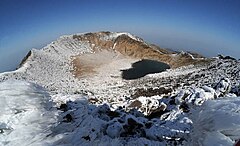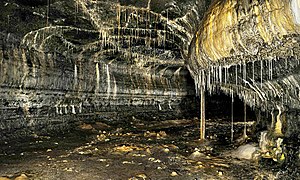Jeju volcanic island and lava tunnel
| Jeju volcanic island and lava tunnel | |
|---|---|
|
UNESCO world heritage |
|

|
|
| The volcanic island of Jejudo |
|
| National territory: |
|
| Type: | nature |
| Criteria : | (vii) (viii) |
| Reference No .: | 1264 |
| UNESCO region : | Asia and Pacific |
| History of enrollment | |
| Enrollment: | 2007 (session 31) |
Jeju Volcanic Island and Lava Tunnel is a UNESCO- listed World Heritage Site in the East Asian state of South Korea . The world heritage site comprises three natural objects on the volcanic island of Jejudo : the Hallasan volcano in the center of the island, the Geomunoreum lava tube system in the northeast and the Seongsan Ilchulbong tuff cone off the coast .
background
The volcanic island of Jejudo is by far the largest island in Korea and is located about 85 km off the southern tip of the Korean Peninsula. It was formed around 1.2 million to 700,000 years ago through a constant process of volcanic eruptions on the sea floor. 300,000 to 100,000 years ago, the Hallasan formed as a shield volcano , which shapes the image of the island and is the highest mountain in South Korea with a height of 1950 meters. Eruptions of the Geomunoreum, a flank volcano of the Hallasan on its eastern flank, created the Geomunoreum lava tube system from several lava tubes that extend from the volcano to the north-northwest to the sea. Off the east coast of the island, the tuff cone of the Seongsan Ilchulbong, rising from the sea , was created from a phreatomagmatic explosion in a period from 5000 years ago to 120,000 years ago .
registration
Jeju volcanic island and lava tunnel was registered as a natural heritage site in the UNESCO World Heritage List in 2007 based on a resolution of the 31st session of the World Heritage Committee.
The world heritage site comprises five areas. These have a total protection area of 9,475.2 ha . The individual protection areas are each surrounded by buffer zones, which have a total area of 9370.8 hectares.
The largest of these areas ( location , protection area 9093.1 ha, buffer zone 7347.4 ha) comprises part of the Hallasan National Park in the center of the island on the slopes of the Hallasan . Three areas belong to the Geomunoreum lava tube system . A first area ( location , protection area 64.6 ha, buffer zone 635.5 ha) comprises the cone of the flank volcano Geomunoreum. A second area ( location , protection area 23.8 ha, buffer zone 635.5 ha) comprises the Bengdwi-gul lava tube . The third area ( location , protection area 241.9 ha, buffer zone 635.4 ha) comprises the Mangjang-gul , Gimnyeong-gul , Yongcheon-donggul and Dangcheomul-donggul lava tubes . The buffer zones of these three areas are adjacent to one another. The last area ( location , protection area 51.8 ha, buffer zone 117 ha) comprises the Seongsan Ilchulbong tuff cone .
The reason for the entry states, among other things:
The site of outstanding aesthetic beauty also gives testimony to the history of the planet, its properties and processes. ... The incomparable quality of the Geomunoreum lava tube system and the display of the various accessible volcanic properties in the two other components offer a distinctive and important contribution to the understanding of global volcanism.
The entry was made on the basis of criteria (vii) and (viii).
(vii): The Geomunoreum lava tube system, which is considered to be the most beautiful cave system of its kind in the world, has an excellent visual impact even for those inexperienced with such phenomena. It shows the unique spectacle of multi-colored carbonate decorations that adorn the ceilings and floors, and dark-colored lava walls that are partially covered by a wall painting made of carbonate deposits. The fortress-like tuff cone Seongsan Ilchulbong, the walls of which jut out of the ocean, is a dramatic feature of the landscape, and Mount Halla with its diverse textures and colors as the seasons change, waterfalls, the display of multi-shaped rock formations and columnar cliffs and the soaring peak with its sea-filled crater add to the scenic and aesthetic appeal.
(viii): Jeju has a special value as one of the few large shield volcanoes in the world that are erected over a hotspot on a stationary continental crustal plate. It is characterized by the Geomunoreum lava tube system, which is the most impressive and significant series of protected lava tube caves in the world and includes a spectacular selection of secondary carbonate speleothems (stalactites and other decorations) with an abundance and variety that is found elsewhere within a lava cave are unknown. The Seongsan Ilchulbong tuff cone has extraordinary exposures of its structural and sedimentological properties, making it a world-class location for understanding Surtseyan volcanic eruptions.
literature
- Jeju Volcanic Island and Lava Tubes . In: Cultural Heritage Administration of South Korea (ed.): World Heritage in Korea . 2011, p. 102-113 (English).
Web links
- Jeju volcanic island and lava tunnel on the UNESCO World Heritage Center website ( English and French ).
Individual evidence
- ↑ English Jeju Volcanic Island and Lava Tubes , German translation according to the World Heritage List. In: Unesco.de. Retrieved February 11, 2017 . , however, island is incorrectly translated as -insel n .
- ↑ a b c d Jeju Volcanic Island and Lava Tubes. In: whc.unesco.org. UNESCO World Heritage Center, accessed February 3, 2017 .
- ↑ Decision: 31 COM 8B.12. In: whc.unesco.org. UNESCO World Heritage Center, accessed February 3, 2017 .
- ^ Jeju Volcanic Island and Lava Tubes. Maps. In: whc.unesco.org. UNESCO World Heritage Center, accessed February 3, 2017 .




